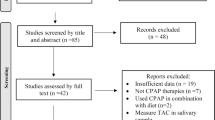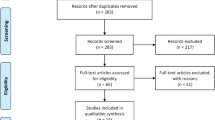Abstract
Purpose
The hypoxia and reoxygenation cycles in obstructive sleep apnea syndrome (OSAS) cause a change in the oxidative balance, leading to the formation of reactive oxygen species capable of reacting with other organic molecules impairing their functions. This study aimed to determine the best markers of oxidative stress in OSAS and what better antioxidant agent to be used to treat the disease.
Methods
Searches were conducted in three different databases (PubMed, LILACS, SCIELO), using as descriptors the terms obstructive sleep apnea, oxidative stress, and antioxidant therapy. A total of 120 articles were found but only those considered of interest to the research were selected. Thus, 10 articles were included for further analysis regarding the biomarkers of oxidative stress in OSAS, and 6 articles to evaluate the antioxidant most often used for demonstration of efficacy.
Results
The thioredoxin, malondialdehyde, superoxide dysmutase, and reduced iron were the most commonly used biomarkers and showed a more consistent relationship between increased oxidative stress and OSAS. As antioxidant therapy, vitamin C and N-acetylcysteine (NAC) presented interesting results as a reduction of oxidative stress, which may become an alternative to the complementary treatment of OSAS.
Conclusions
This review’s findings agree mostly to measure that the markers of oxidative stress in OSAS may be a contributing aspect to assessment and monitoring of patient, and the antioxidant therapy appears to be beneficial in the treatment of OSAS.
Similar content being viewed by others
References
American Academy Sleep Medicine Task Force (1999) Sleep-related breathing disorders in adults: recommendations for syndrome definition and measurement techniques in clinical research. Sleep 22(5):667–689
Lavie L (2003) Obstructive sleep apnoea syndrome—an oxidative stress disorder. Sleep Med Rev 7(1):35–51
Celec P, Jurkovicová I, Buchta R, et al. (2013) Antioxidant vitamins prevent oxidative and carbonyl stress in an animal model of obstructive sleep apnea. Sleep Breath 17:867–871
Cofta S, Wysocka E, Piorunek T, et al. (2008) Oxidative stress markers in the blood of persons with different stages of obstructive sleep apnea syndrome. J Physiol Pharmacol 59(6):183–190
Nieto FJ, Young TB, Lind BK, et al. (2000) Association of sleep-disordered breathing, sleep apnea, and hypertension in a large community-based study. JAMA 283(14):1829–1836
Peppard PE, Young T, Palta M, et al. (2000) Prospective study of the association between sleep-disordered breathing and hypertension. N Engl J Med 342(19):1378–1384
Li J, Thorne LN, Punjabi NM, et al. (2005) Intermittent hypoxia induces hyperlipidemia in lean mice. Circ Res 97:698–706
Sousa-Rodrigues CF, Lira AB (2015) Correlation between the severity of apnea and hypopnea sleep, hypertension and serum lipid and glycemic: a case control study. Eur Arch Otorhinolaryngol 272(6):1509–1515
American Academy Sleep Medicine (2005) International classification of sleep disorders (ICSD-2): Diagnostic & coding manual. Westchester, 2 nd edition.
Volná J, Kemlink D, Kalousová M, et al. (2011) Biochemical oxidative stress-related markers in patients with obstructive sleep apnea. Med Sci Monit 17(9):491–497
Guo Q, Wang Y, Li QY, et al. (2012) Levels of thioredoxin are related to the severity of obstructive sleep apnea: based on oxidative stress concept. Sleep Breath 17(1):311–316
Takahashi K, Chin K, Nakamura H, et al. (2008) Plasma thioredoxin, a novel oxidative stress marker, in patients with obstructive sleep apnea before and after nasal continuous positive airway pressure. Antioxid Redox Signal 10(4):715–726
Ntalapascha M, Makris D, Kyparos A, et al. (2012) Oxaditive stress in patients with obstructive sleep apnea syndrome. Sleep Breath 17(2):549–555
Alzoghaibi MA, Bahammam SA (2005) Lipid peroxides, superoxide dismutase and circulating Il-8 and GCP-2 in patients with severe obstructive sleep apnea: a pilot study. Sleep Breath 9(3):119–126
Jordan W, Cohrs S, Degner D, et al. (2006) Evaluation of oxidative stress measurements in obstructive sleep apnea syndrome. J Neural Transm 113(2):239–254
Mancuso M, Bonanni E, LoGerfo A, et al. (2012) Oxidative stress biomarkers in patients with untreated obstructive sleep apnea syndrome. Sleep Med 13(6):632–636
Simiakakis M, Kapsimalis F, Chaligiannis E, et al. (2012) Lack of effect of sleep apnea on oxidative stress in obstructive sleep apnea syndrome (OSAS) patients. PLoS One 7(6):e39172
Katsoulis K, Kontakiotis T, Spanogiannis D, et al. (2011) Total antioxidant status in patients with obstructive sleep apnea without comorbidities: the role of the severity of the disease. Sleep Breath 15:861–866
Sadasivam K, Patial K, Vijayan VK, et al. (2011) Anti-oxidant treatment in obstructive sleep apnoea syndrome. Indian J Chest Dis Allied Sci 53:153–162
Grebe M, Eisele HJ, Weissmann N, et al. (2006) Antioxidant vitamin C improves endothelial function in obstructive sleep apnea. Am J Respir Crit Care Med 173:897–901
Inamoto S, Yoshioka T, Yamashita C, et al. (2010) Pitavastatin reduces oxidative stress and attenuates intermittent hypoxia-induced left ventricular remodeling in lean mice. Hypertens Res 33(6):579–586
Williams AL, Chen L, Scharf SM (2010) Effects of allopurinol on cardiac function and oxidant stress in chronic intermittent hypoxia. Sleep Breath 14:51–57
Macrea M, Martin T, Zagrean L, et al. (2013) Role of leptin as antioxidant in obstructive sleep apnea: an in vitro study using electron paramagnetic resonance method. Sleep Breath 17(1):105–110
Acknowledgments
The authors would like to thank the University of Alagoas/Brazil.
Author information
Authors and Affiliations
Corresponding author
Ethics declarations
Ethical approval
For this type of study, formal consent is not required.
Conflicts of interest
The authors declare that they have no competing interests.
Funding
No founding was received for this research.
Rights and permissions
About this article
Cite this article
Lira, A.B., de Sousa Rodrigues, C.F. Evaluation of oxidative stress markers in obstructive sleep apnea syndrome and additional antioxidant therapy: a review article. Sleep Breath 20, 1155–1160 (2016). https://doi.org/10.1007/s11325-016-1367-3
Received:
Revised:
Accepted:
Published:
Issue Date:
DOI: https://doi.org/10.1007/s11325-016-1367-3




